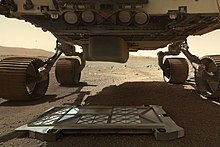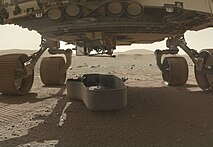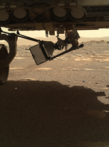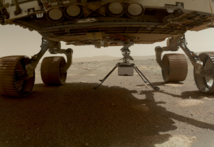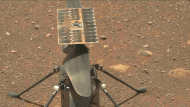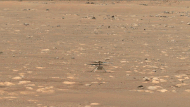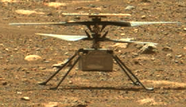
A | B | C | D | E | F | G | H | CH | I | J | K | L | M | N | O | P | Q | R | S | T | U | V | W | X | Y | Z | 0 | 1 | 2 | 3 | 4 | 5 | 6 | 7 | 8 | 9
| Ingenuity | |
|---|---|
| Part of Mars 2020 | |
 Ingenuity at Wright Brothers Field on April 6, 2021, its third day of deployment on Mars | |
| Type | Extraterrestrial autonomous UAV helicopter |
| Serial no. | IGY (civil registration) |
| Owner | NASA |
| Manufacturer | Jet Propulsion Laboratory |
| Specifications | |
| Dimensions | 121 cm × 49 cm × 52 cm (48 in × 19 in × 20 in) |
| Dry mass | 1.8 kilograms (4.0 lb)[1] |
| Communication | Zigbee transponder with base station on Perseverance |
| Power | 6 Solar-charged Sony VTC4 Li ion batteries; typical motor input power: 350 watt[2] |
| Instruments | |
| |
| History | |
| Deployed |
|
| First flight |
|
| Last flight |
|
| Flights | 72 |
| Flight time | 2 hr 8 min 55 sec, cumulative |
| Travelled |
Data from NASA Mars Helicopter Flight Log
|
| Fate | Retired due to sustained rotor blade damage[4] |
| Location | Jezero crater, Mars[3] |
| NASA Mars helicopters | |
Ingenuity, nicknamed Ginny, is an autonomous NASA helicopter that operated on Mars from 2021 to 2024 as part of the Mars 2020 mission. Ingenuity made its first flight on April 19, 2021, demonstrating that flight is possible in the extremely thin atmosphere of Mars, and becoming the first aircraft to conduct a powered and controlled extra-terrestrial flight. It was designed by NASA's Jet Propulsion Laboratory (JPL) in collaboration with AeroVironment, NASA's Ames Research Center and Langley Research Center with some components supplied by Lockheed Martin Space, Qualcomm, and SolAero.
Ingenuity was delivered to Mars on February 18, 2021, attached to the underside of the Perseverance rover, which landed at Octavia E. Butler Landing near the western rim of the 45 km-wide (28 mi) Jezero crater. Because radio signals take between five and 20 minutes to travel between Earth and Mars, depending on the planets' positions, it could not be controlled directly in real time but flew autonomously to execute flight plans designed and sent to it by JPL.
Originally intended to make only five flights, Ingenuity completed 72 flights in nearly three years. The five planned flights were part of a 30-sol technology demonstration intended to prove its airworthiness with flights of up to 90 seconds at altitudes ranging from 3–5 m (10–16 ft). Following this demonstration, JPL designed a series of operational flights to explore how aerial scouts could help explore Mars and other worlds. In this operational role, Ingenuity scouted areas of interest for the Perseverance rover, improved navigational techniques, and explored the limits of its flight envelope. Ingenuity's performance and resilience in the harsh Martian environment greatly exceeded expectations, allowing it to perform far more flights than were initially planned. On January 18, 2024, Ingenuity's rotor blades were damaged while landing on its 72nd flight, permanently grounding the helicopter. NASA announced the end of its mission one week later. Ingenuity had flown for a total of two hours, eight minutes and 48 seconds over 1,004 days, covering more than 17 kilometres (11 mi).
Development
Concept
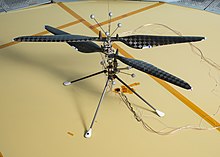
The development of the project that would eventually become Ingenuity started in 2012 when JPL director Charles Elachi visited the lab's Autonomous Systems Division, which had done relevant concept work. By January 2015, NASA agreed to fund the development of a full-size model, which came to be known as the "risk reduction" vehicle.[5] NASA's JPL and AeroVironment published the conceptual design in 2014 for a scout helicopter to accompany a rover.[6][7][8] By mid-2016, $15 million was being requested to continue development of the helicopter.[9]
By December 2017, engineering models of the vehicle had been tested in a simulated Martian atmosphere.[10][11] Models were undergoing testing in the Arctic, but its inclusion in the mission had not yet been approved or funded.[12]
Mission integration
When the Mars 2020 program was approved in July 2014,[13] a helicopter flight demonstration was neither included nor budgeted.[14]
The United States federal budget, announced in March 2018, provided $23 million for the helicopter for one year,[15][16] and it was announced on May 11, 2018, that the helicopter could be developed and tested in time to be included in the Mars 2020 mission.[17] The helicopter underwent extensive flight-dynamics and environment testing,[10][18] and was mounted on the underside of the Perseverance rover in August 2019.[19] NASA spent about $80 million to build Ingenuity and about $5 million to operate the helicopter.[20]
In 2019, preliminary designs of Ingenuity were tested on Earth in simulated Mars atmospheric and gravity conditions. For flight testing, a large vacuum chamber was used to simulate the very low pressure of the atmosphere of Mars – filled with carbon dioxide to about 0.60% (about 1⁄160) of standard atmospheric pressure at sea level on Earth – which is roughly equivalent to a helicopter flying at 34,000 m (112,000 ft) altitude in the atmosphere of Earth. In order to simulate the much-reduced gravity field of Mars (38% of Earth's), 62% of Earth's gravity was offset by a line pulling upwards during flight tests.[21] A "wind-wall" consisting of almost 900 computer fans was used to provide wind in the chamber.[22][23]: 1:08:05–1:08:40
In April 2020, the vehicle was named Ingenuity by Vaneeza Rupani, a girl in the 11th grade at Tuscaloosa County High School in Northport, Alabama, who submitted an essay into NASA's "Name the Rover" contest.[24][25] Known in planning stages as the Mars Helicopter Scout,[26] or simply the Mars Helicopter,[27] the nickname Ginny later entered use in parallel to the parent rover Perseverance being affectionately referred to as Percy.[28] Its full-scale engineering model for testing on Earth was named Earth Copter and, unofficially, Terry.[29]
Ingenuity was designed to be a technology demonstrator by JPL to assess whether such a vehicle could fly safely. Before it was built, launched and landed, scientists and managers expressed hope that helicopters could provide better mapping and guidance that would give future mission controllers more information to help with travel routes, planning, and hazard avoidance.[17][30][31] Based on the performance of previous rovers through Curiosity, it was assumed that such aerial scouting might enable future rovers to safely drive up to three times as far per sol.[32][33] However, the new AutoNav capability of Perseverance significantly reduced this advantage, allowing the rover to cover more than 100 meters per sol.[34]
Development team
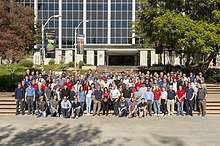
The Ingenuity team was comparatively small, with never more than 65 full-time-equivalent employees from JPL. Program workers from AeroVironment, NASA AMES and Langley research centers brought the total to 150.[5] Key personnel include:
- MiMi Aung – Ingenuity Mars Helicopter Project Manager at NASA's Jet Propulsion Laboratory,[35][36][37][5]
- Bob Balaram – Chief Engineer (prior to Nov 2021)[38][39][40][41]
- Timothy Canham – Flight Software Lead and Operations Lead (prior to June 2021)[42][43][44]
- Håvard Fjær Grip – GNC Lead and Chief Pilot[45][46][47][41][48][49]
- Matt Keennon – AeroVironment Technical Lead[8]
- Ben Pipenberg – AeroVironment Design Lead[8]
- Josh Ravich – Mechanical Engineering Lead[50][51]
- Teddy Tzanetos – Operations Lead[52][53][49]
- Nacer Chahat – Antenna Engineer and Telecom System Engineering[54][55][56]
On June 15, 2021, the team behind Ingenuity was named the 2021 winner of the John L. "Jack" Swigert Jr. Award for Space Exploration from the Space Foundation.[57] On April 5, 2022, the National Aeronautic Association awarded Ingenuity and its group in JPL the 2021 Collier Trophy.[58][59]
Opposition
The idea to include a helicopter in the Mars 2020 mission was opposed by several people. Up until the end of the 2010s, several NASA leaders, scientists and JPL employees argued against integrating a helicopter into the mission. For three years, the future Ingenuity was developed outside the Mars 2020 project and its budget.[60][61] And although NASA management accepted assurances in the spring of 2018 that the addition of a helicopter would not harm the goals of the expedition, Mars 2020 chief scientist, Kenneth Farley, stated "I have personally been opposed to it because we are working very hard for efficiencies and spending 30 days working on a technology demonstration does not further those goals directly from the science point of view".[62] Farley was convinced that the helicopter was a distraction from the priority scientific tasks, unacceptable even for a short time.[62]
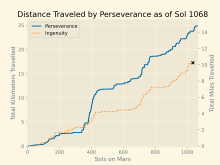
The skepticism on the part of NASA leadership was not unfounded. Scientists, engineers and managers proceeded from a pragmatic comparison of the benefits of additional aerial reconnaissance with the costs that inevitably fall on the schedule for the rover to complete all the tasks assigned to it. During a live-stream from NASA, MiMi Aung, the Ingenuity Project Manager, and Jennifer Trosper discussed the value of Ingenuity. Trosper argued that the rover would outpace the helicopter due to its auto-navigation capability, thus negating one of central arguments for the value to the mission of the helicopter. During the operations on Mars, Trosper was shown to be correct when, in the spring of 2022, at the beginning of Sol 400 the helicopter fell behind the rover.
At the end of the "test window", NASA extended support for Ingenuity for another 30 sols, limiting the frequency of departures to one flight every few weeks.
On 14 June 2021, the Director of the Mars Exploration program, E. Janson, and the Principal Mars Explorer, M. Meyer, directly addressed all the staff of the Mars 2020 project. During this address they cautioned the staff to keep their Ingenuity enthusiasm in check, and concentrate on collecting samples. On the same date, in their report to the Planetary Advisory Committee (PAC), the helicopter was mentioned only in the past tense, e.g. "...placed Ingenuity and completed the technology demonstration phase...".[63] Despite this early pessimism, Ingenuity has since proved to be more than capable of keeping up with Perseverance, actually staying ahead of the rover for the majority of the traverse up the Jezero delta.[64]
Insufficient solar energy during the Martian winter was the main driver of poor operational performance in the latter half of 2022.[65]
Design
Mechanical design
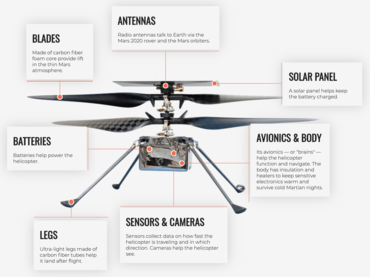
Ingenuity consists of a rectangular fuselage measuring 136 mm × 195 mm × 163 mm (5.4 in × 7.7 in × 6.4 in) suspended below a pair of coaxial counter-rotating rotors measuring 1.21 m (4 ft) in diameter.[1][11][27] This assembly is supported by four landing legs of 384 mm (15.1 in) each.[1] It also carries a solar array mounted above the rotors to recharge its batteries. The entire vehicle is 0.49 m (1 ft 7 in) tall.[1]

A – Rotor blade; B – Pitch link; C – Servo; D – Swashplate
The lower gravity of Mars (about a third of Earth's) only partially offsets the thinness of the 95% carbon dioxide atmosphere of Mars,[66] making it much harder for an aircraft to generate adequate lift. The planet's atmospheric density is about 1⁄100 that of Earth's at sea level, or about the same as at 27,000 m (87,000 ft), an altitude never reached by existing helicopters. This density reduces even more in Martian winters. To keep Ingenuity aloft, its specially shaped blades of enlarged size must rotate between 2400 and 2900 rpm, or about 10 times faster than what is needed on Earth.[11][67][68] Each of the helicopter's contra-rotating coaxial rotors is controlled by a separate swashplate that can affect both collective and cyclic pitch.[69] Ingenuity was also constructed to spacecraft specifications to withstand the acceleration and vibrations during launch and Mars landing without damage.[68]
Avionics
Ingenuity relies on different sensor packages grouped in two assemblies. All sensors are commercial off-the-shelf units.
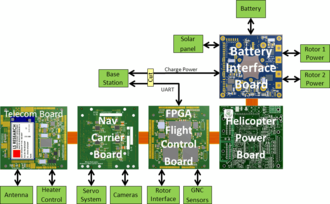
The Upper Sensor Assembly, with associated vibration isolation elements, is mounted on the mast close to the vehicle's center-of-mass to minimize the effects of angular rates and accelerations. It consists of a cellphone-grade Bosch BMI-160 Inertial measurement unit (IMU) and an inclinometer (Murata SCA100T-D02); the inclinometer is used to calibrate the IMU while on the ground prior to flight. The Lower Sensor Assembly consists of an altimeter (Garmin LIDAR Lite v3), cameras, and a secondary IMU, all mounted directly on the Electronics Core Module (not on the mast).[69]
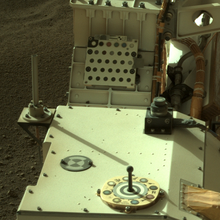
Ingenuity uses a 425×165 mm solar panel to recharge its batteries, which are six Sony Li-ion cells with 35–40 Wh (130–140 kJ) of energy capacity[21] (nameplate capacity of 2 Ah).[10] Flight duration is not constrained by available battery power, but by thermals – during flight, the drive motors heat up by 1 °C every second, and the thin Martian atmosphere makes for poor heat dissipation.[70] The helicopter uses a Qualcomm Snapdragon 801 processor running a Linux operating system.[42] Among other functions, it controls the visual navigation algorithm via a velocity estimate derived from terrain features tracked with the navigation camera.[71] The Qualcomm processor is connected to two radiation-resistant flight-control microcontrollers (MCUs) to perform necessary control functions.[10]
The telecommunication system consists of two identical radios with monopole antennae for data exchange between the helicopter and rover. The radio link utilizes the low-power Zigbee communication protocols, implemented via 914 MHz SiFlex 02 chipsets mounted in both vehicles. The communication system is designed to relay data at 250 kbit/s over distances of up to 1,000 m (3,300 ft).[54] The omnidirectional antenna is part of the helicopter's solar panel assembly and weighs 4 grams.[72]
Cameras and photography
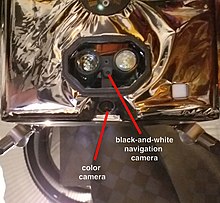
Ingenuity is equipped with two commercial-off-the-shelf (COTS) cameras: a high-resolution Return to Earth (RTE) camera and a lower resolution navigation (NAV) camera. The RTE camera consists of the Sony IMX214, a rolling shutter, 4208 × 3120-pixel resolution color sensor with a built-in Bayer color filter array and fitted to an O-film optics module. The NAV camera consists of an Omnivision OV7251, a 640 × 480 black and white global shutter sensor, mounted to a Sunny optics module.[10]
Unlike Perseverance, Ingenuity does not have a special stereo camera for taking twin photos for 3D pictures simultaneously. However, the helicopter can make such images by taking duplicate color photos of the same terrain while hovering in slightly offset positions, as in flight 11, or by taking an offset picture on the return leg of a roundtrip flight, as in flight 12.[73]
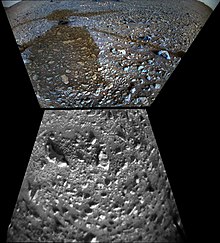
While the RTE color camera is not necessary for flights (as in flights 7 and 8[52]), the NAV camera operates continuously throughout each flight, with the captured images used for visual odometry to determine the aircraft's position and motion during flight. Due to limitations on the transmission rate between the aircraft, the rover, and Earth, only a limited number of images can be saved from each flight. Images to save for transmission are defined by the flight plan prior to each flight, and the remaining images from the NAV camera are discarded after use.[citation needed]
As of December 16, 2021, 2,091 black-and-white images from the navigation camera[74] and 104 color images from the terrain camera (RTE)[75] have been published.
| Flight No. | Date (UTC) and Mars 2020 mission sol | Photographs | Comments | |
|---|---|---|---|---|
| b/w NAV |
color RTE | |||
| Before April 19, 2021 (sol 58) | 6[76] | 6[77] | Preflight camera tests | |
| 1 | April 19, 2021 (sol 58) | 15 | — | |
| 2 | April 22, 2021 (sol 61) | 17 | 3 | The first color photo session |
| 3 | April 25, 2021 (sol 64) | 24 | 4 | |
| 4 | April 30, 2021 (sol 69) | 62 | 5 | |
| 5 | May 7, 2021 (sol 76) | 128 | 6 | |
| 6 | May 23, 2021 (sol 91) | 106 | 8 | |
| 7 | June 8, 2021 (sol 107) | 72 | 0 | RTE was turned off[52] |
| 8 | June 22, 2021 (sol 121) | 186 | 0 | |
| 9 | July 5, 2021 (sol 133) | 193 | 10 | |
| 10 | July 24, 2021 (sol 152) | 190 | 10 | Five pairs of color images of Raised Ridges taken to make anaglyphs.[53] |
| 11 | August 5, 2021 (sol 164) | 194 | 10 | |
| 12 | August 16, 2021 (Sol 174) | 197[78] | 10 | Five pairs of color images of Séítah taken to make anaglyphs.[49] |
| 13 | September 5, 2021 (Sol 193) | 191[79] | 10 | |
| September 16, 2021 (Sol 204) to October 23, 2021 (Sol 240) | 9 | 1 | preflight 14 tests | |
| 14 | October 24, 2021 (Sol 241) | 182 | — | |
| 15 | November 6, 2021 (Sol 254) | 191 | 10 | |
| November 15, 2021 (Sol 263) | — | 1 | ground color photo[80] | |
| 16 | November 21, 2021 (Sol 268) | 185 | 9 | |
| November 27, 2021 (Sol 274) | — | 1 | ground color photo[80] | |
| 17 | December 5, 2021 (Sol 282) | 192 | — | |
| 18 | December 15, 2021 (Sol 292) | 184 | — | |
| December 20, 2021 (Sol 297) to February 3, 2022 (Sol 341) | 10 | 1 | preflight 19 tests and post-dust storm debris removal operations | |
| 19 | February 8, 2022 (Sol 346) | 92 | — | |
| 20 | February 25, 2022 (Sol 362) | 110 | 10 | |
| February 27, 2022 (Sol 364) | — | 1 | preflight 21 tests | |
| 21 | March 10, 2022 (Sol 375) | 191 | — | |
Flight software
The helicopter uses autonomous control during its flights, which are telerobotically planned and scripted by operators at Jet Propulsion Laboratory (JPL). It communicates with the Perseverance rover directly before and after each landing.[23]: 1:20:38–1:22:20
The flight control and navigation software on the Ingenuity can be updated remotely, which has been used to correct software bugs[81][52] and add new capabilities between flights. Prior to flight 34, the software was updated to avoid hazards during landing and to correct a navigation error when traveling over uneven terrain. This update became necessary as the helicopter traveled away from the relatively flat terrain of the original landing site, and towards more varied and hazardous terrain.[82]
Specifications
| Rotor speed | 2400–2700 rpm[1][27][83] |
| Blade tip speed | <0.7 Mach[26] |
| Originally planned operational time | 1 to 5 flights within 30 sols[1][2] |
| Flight time | Up to 167 seconds per flight[84] |
| Maximum range, flight | 704 m (2,310 ft) |
| Maximum range, radio | 1,000 m (3,300 ft)[10] |
| Maximum altitude | 24 m (79 ft)[85] |
| Maximum possible speed | |
| Battery capacity | 35–40 Wh (130–140 kJ)[21] |
Operational history
Primary mission
Perseverance dropped the debris shield protecting Ingenuity on March 21, 2021, and the helicopter deployed from the underside of the rover to the Martian surface on April 3, 2021.[86] That day both cameras of the helicopter were tested taking their first black-and-white and color photographs of the floor of Jezero Crater in the shadow of the rover.[87][77] After deployment, the rover drove about 100 m (330 ft) away from the drone to allow a safe flying zone.[88][89]
Ingenuity's rotor blades were unlocked on April 8, 2021, (mission sol 48), and the helicopter performed a low-speed rotor spin test at 50 rpm.[90][91][92][93][94]
A high-speed spin test was attempted on April 9, but failed due to the expiration of a watchdog timer, a software measure to protect the helicopter from incorrect operation in unforeseen conditions.[95] On April 12, JPL said it identified a software fix to correct the problem.[81] To save time, however, JPL decided to use a workaround procedure, which managers said had an 85% chance of succeeding and would be "the least disruptive" to the helicopter.[35]
On April 16, 2021, Ingenuity passed the full-speed 2400 rpm rotor spin test while remaining on the surface.[96][97] Three days later, April 19, JPL flew the helicopter for the first time. The watchdog timer problem occurred again when the fourth flight was attempted. Rescheduled for April 30, the fourth flight captured numerous color photos and explored the surface with its black-and-white navigation camera.[37]
On June 25, JPL said it had uploaded a software update the previous week to permanently fix the watchdog problem, and that a rotor spin test and the eighth flight confirmed that the update worked.[52]
Each flight was planned for altitudes ranging 3–5 m (10–16 ft) above the ground, though Ingenuity soon exceeded that planned height.[1] The first flight was a hover at an altitude of 3 m (9.8 ft), lasting about 40 seconds and including taking a picture of the rover. The first flight succeeded, and subsequent flights were increasingly ambitious as allotted time for operating the helicopter dwindled. JPL said the mission might even stop before the 30-day period ended, in the likely event that the helicopter crashed,[23]: 0:49:50–0:51:40 an outcome which did not occur. In up to 90 seconds per flight, Ingenuity could travel as far as 50 m (160 ft) downrange and then back to the starting area, though that goal was also soon exceeded with the fourth flight.[1][37]
The commissioning sequence was as follows:

After the successful first three flights, the objective was changed from technology demonstration to operational demonstration. Ingenuity flew through a transitional phase of two flights, 4 and 5, before beginning its operations demonstration phase.[98] By November 2023, the principal mission priorities had become:[99]
- Avoid significant interference with, or delay of, rover operations Zdroj:https://en.wikipedia.org?pojem=Ingenuity_(helicopter)
Text je dostupný za podmienok Creative Commons Attribution/Share-Alike License 3.0 Unported; prípadne za ďalších podmienok. Podrobnejšie informácie nájdete na stránke Podmienky použitia.
Antropológia
Aplikované vedy
Bibliometria
Dejiny vedy
Encyklopédie
Filozofia vedy
Forenzné vedy
Humanitné vedy
Knižničná veda
Kryogenika
Kryptológia
Kulturológia
Literárna veda
Medzidisciplinárne oblasti
Metódy kvantitatívnej analýzy
Metavedy
Metodika
Text je dostupný za podmienok Creative
Commons Attribution/Share-Alike License 3.0 Unported; prípadne za ďalších
podmienok.
Podrobnejšie informácie nájdete na stránke Podmienky
použitia.
www.astronomia.sk | www.biologia.sk | www.botanika.sk | www.dejiny.sk | www.economy.sk | www.elektrotechnika.sk | www.estetika.sk | www.farmakologia.sk | www.filozofia.sk | Fyzika | www.futurologia.sk | www.genetika.sk | www.chemia.sk | www.lingvistika.sk | www.politologia.sk | www.psychologia.sk | www.sexuologia.sk | www.sociologia.sk | www.veda.sk I www.zoologia.sk

